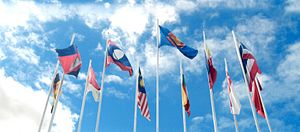The 32nd Association of Southeast Asian Nations (ASEAN) Leaders’ Summit concluded in Singapore on April 28. ASEAN’s norms of consensus were on full display as differences among member states on policy towards the South China Sea were resolved by deleting contentious remarks in their entirety.
On April 20, ASEAN officials drew up a consolidated Zero Draft of Chairman’s Statement on 32nd ASEAN Summit. The section on regional and international issues and developments contained seven points on the South China Sea. As noted in a previous report by The Diplomat, four of the points were subject to 16 interventions by members including seven from Cambodia or nearly 44 percent of the total.
As a result of discussions among ASEAN senior officials and ministers the draft of the Chairman’s Statement was revised on April 26. The Diplomat reviewed this document and discovered that six of the original seven points (numbers 15-20) in the Zero Draft, were deleted in their entirety. This deletion has been confirmed with the official release of the Chairman’s Statement on the official ASEAN Secretariat website on April 28.
It is difficult to reconcile the deletion of these points with ASEAN’s fulsome endorsement of “an ASEAN-centric regional architecture that is open, transparent, inclusive and rules-based” and ASEAN’s commitment to “full respect for legal and diplomatic processes… in accordance with the universally recognized principles of international law, including the 1982 United Nations Convention on the Law of the Sea (UNCLOS).” ASEAN leaders deleted point 17 that included reference to “legal and diplomatic processes” and a proposal by Vietnam and the Philippines to welcome the “award by the Arbitral Tribunal constituted under Annex VII to the UNCLOS.”
Current ASEAN policy on the South China Sea, as reflected in Point 23 (formerly 14 in the Zero Draft) of the official Chairman’s Statement does not mention the Arbitral Tribunal or legal and diplomatic process.
ASEAN policy on the South China Sea has now been boiled down to seven points.
First, ASEAN reaffirms “the importance of freedom of navigation and overflight above the South China Sea.”
Second, ASEAN underscores the importance of “the full and effective implementation of the 2002 Declaration on the Conduct of Parties in the South China Sea (DOC) in its entirely.”
Third, ASEAN warmly welcomes “the improving cooperation between ASEAN and China” specifically “the official commencement of the substantive negotiation towards the early conclusion of an effective Code of Conduct in the South China Sea (COC) on a mutually-agreed timeline.”
Fourth, ASEAN also welcomes practical measures that could reduce tensions, accidents, misunderstandings and miscalculation such as the successful testing of the hotline between ASEAN members and China “to manage emergencies in the South China Sea” and the operationalization of the Code for Unplanned Encounters at Sea (CUES).
Fifth, ASEAN takes “note of the concerns expressed by some Leaders on the land reclamations and activities in the area, that have eroded trust and confidence, increased tensions and many undermine peace, security and stability in the region.”
Sixth ASEAN “reaffirmed the need to enhance mutual trust and confidence, exercise self-restraint in the conduct of activities and avoid actions that may further complicate the situation and pursue peaceful resolution of disputes in accordance with international law, including the 1982 UNCLOS.”
Seventh, ASEAN “emphasized the importance of non-militarisation and self-restraint in the conduct of activities by claimants and all other states, including those mentioned in the DOC that could further complicate the situation and escalate tensions in the South China Sea.” This is a reference to China.
There must be some irony that while ASEAN Leaders were busy deleting paragraphs on the South China Sea, the ASEAN Chair was seeking support from ASEAN foreign ministers to write to the Chair of the Non-Aligned Movement (NAM) in essence to protest the non-inclusion of an ASEAN reservation in the Final Document issued by the 18th Mid-Term Ministerial Meeting held in Baku, Azerbaijan from 3-6 April.
The Diplomat has viewed a copy of the letter from the ASEAN Chair to all ASEAN Foreign Ministers (April 23) and the proposed draft letter to be sent to the NAM (April 27).
The ASEAN Chair’s draft letter to the NAM expressed deep disappointment that ASEAN’s update to the Southeast Asian section (paragraph 526) was not incorporated in the Final Document for the second consecutive year. In September 2016, ASEAN filed a reservation on the wording of the Southeast Asian section (paragraph 449) at the 17th NAM Summit that was not incorporated in the final statement.
Paragraph 526 dealt with the South China Sea. NAM protocol would normally incorporate the views of ASEAN as the recognized regional organization for Southeast Asia. In 2016 and again in 2018 NAM bowed to Chinese pressure and ASEAN’s proposed updates were not included.
The wording that ASEAN sought to include in paragraph 526 of the Final Document of the 18th NAM Mid-Term Meeting is exactly the same as point 14 of the Zero Draft of the Chairman’s Statement of 32nd ASEAN Summit and was the only point from the Zero Draft to be included in the official Chairman’s Statement of the 32nd ASEAN Summit on April 28.
In sum, ASEAN is pleading with the Non-Aligned Movement to incorporate its views on the South China Sea in a Final Document while, at the same time, ASEAN Leaders’ have declined to incorporate the updated views of some of its members on the South China Sea in the Chairman’s Statement.
The 32nd ASEAN Leaders’ Summit and its handling of members’ views on the South China Sea has served to undermine ASEAN’s commitment to be open, transparent, and inclusive. Cambodia has helped set a new ASEAN norm of consensus by deletion in parallel with its patron, China, that applied the same tactic in the Non-Aligned Movement.
































